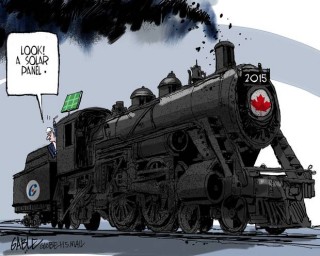This article examines a report from a prominent group of economists that suggests that the practical provincial carbon emission plans are superior to the federal government’s regulatory approach.
Appropriate Subject Area(s):
Environmental studies, world issues, economics, politics
Key Questions to Explore:
- What is the essence of a carbon tax plan?
- How does cap-and-trade work?
- What is a regulatory approach?
New Terminology:
Cap-and-trade, carbon tax
Materials Needed:
Access to the Internet
Introduction to lesson and task:
The lack of federal leadership on reducing carbon emissions has been well documented and much lamented. In the absence of this leadership the provinces are stepping forward and introducing their own plans to address greenhouse gas emissions. The latest to come on board is Ontario, which is adopting a cap-and-trade approach. The latest in a long line of reports that find the federal approach less than desirable comes from a group of prominent economists backed by highly respected former politicians, who argue that the practical provincial approach is superior to the regulatory approach and urge the federal government to step up its efforts to meet its UN climate commitments. The federal government, however, has just shelved its regulatory efforts, arguing that the recent drop in crude oil prices has made it even less desirable to harm the oil industry further by introducing restrictive legislation. This would actually appear to suit the federal government’s lack of national leadership and provide it with a rationale as to why Canada has failed to meet its commitments.
Action (lesson plan and task):
- Begin the lesson by asking the students to explain and characterize Ontario’s recent decision regarding carbon plans.
- If they can identify that Ontario has committed to a cap-and-trade approach ask them to briefly explain what this involves.
- If they cannot identify the approach that Ontario has chosen, identify it for them and indicate that it is one of three that are being discussed in Canada.
- Ask them if they can identify the three different approaches – cap-and-trade, carbon tax and sector regulations.
- Briefly discuss the three approaches with them.
- As background to the task to follow, provide them with a copy of the article and allow them time to read it.
- Divide the class into working groups of five or six students and assign them the following role play and task:
You are the inner cabinet of a provincial government which does not currently have a stated carbon plan. You are facing a provincial election in the very near future and the issue of greenhouse gas emissions and climate change is a real hot potato. The electorate is demanding a clear statement of position concerning a carbon plan from your party.
Carefully research the three approaches and prepare your party’s position on a climate plan and prepare a report that clearly outlines your party’s position.
Consolidation of Learning:
- The groups will present their chosen carbon plan and explain it to the class.
Success Criteria:
- The students will be able to identify the three carbon strategies and explain why the federal government’s regulatory approach is inferior to the provinces’ more practical carbon plans.
Confirming Activity:
- For homework have the students draft a detailed version of the following statement:
“As Prime Minister I would take the following actions to address the issue of climate change and greenhouse gas emissions.”

